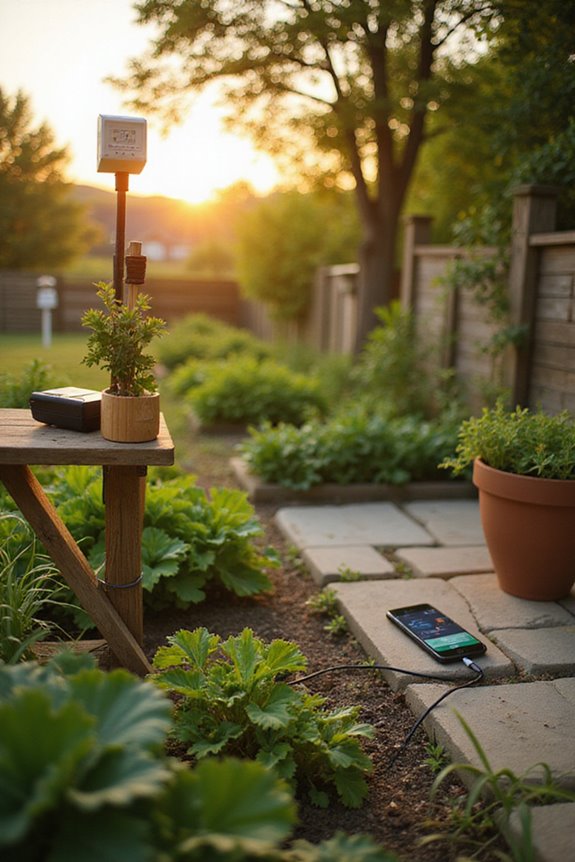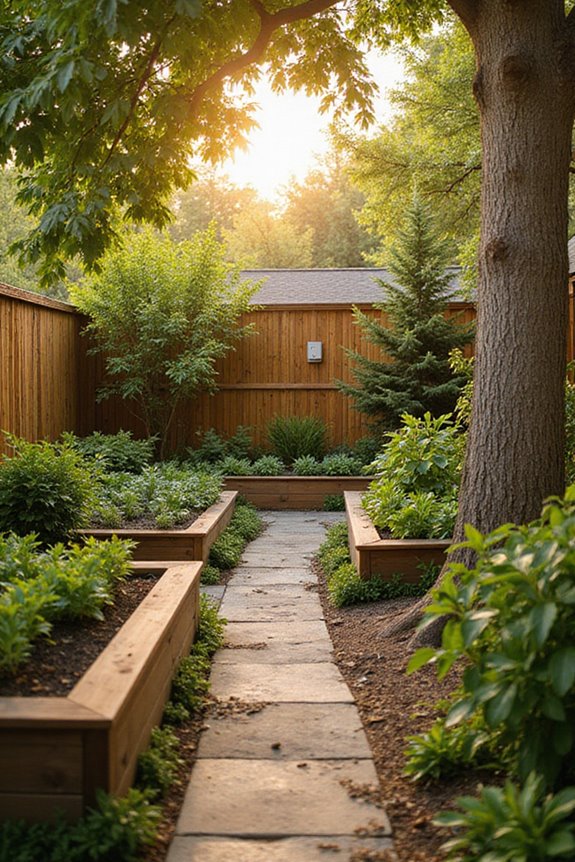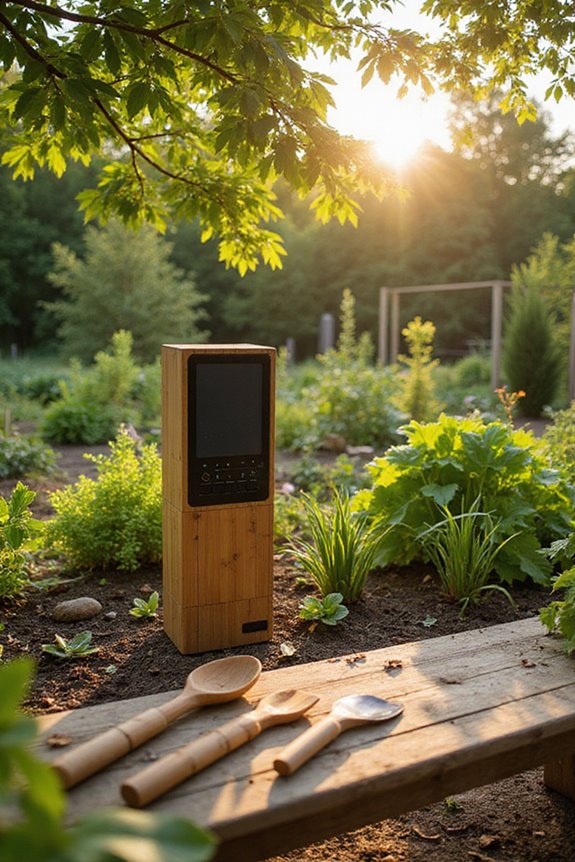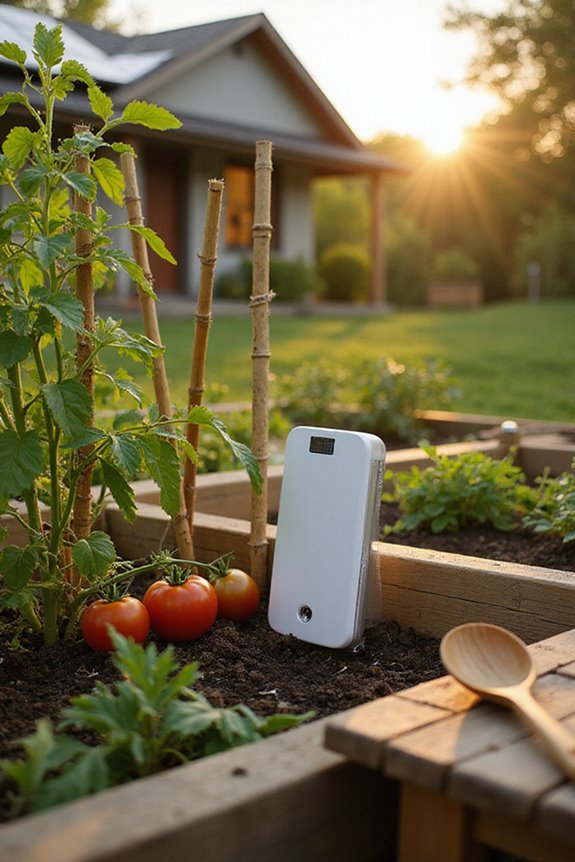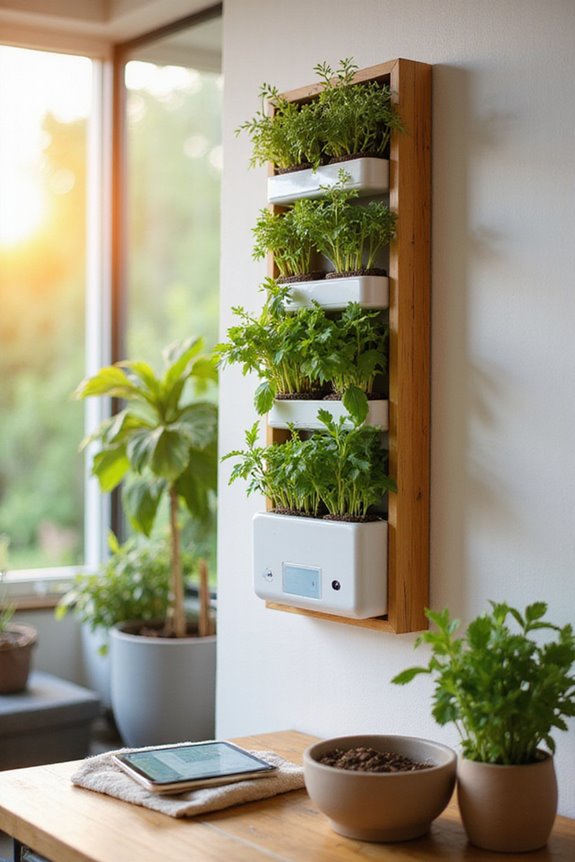When it comes to IoT garden sensor options, we’ve got several effective choices. 1) Soil moisture sensors help us measure soil moisture accurately. 2) Wireless sensors, like SenseCAP and WH51, offer real-time data access. 3) Temperature and humidity sensors keep track of climate conditions essential for plant health. 4) Light sensors manage garden lights efficiently. 5) Precipitation sensors, like tipping bucket gauges, guarantee we use water wisely. We can discover even more options as we explore further.
Key Takeaways
- Soil moisture sensors measure soil moisture levels using electrical conductivity or dielectric properties for optimal irrigation management.
- Wireless soil moisture sensors, like SenseCAP and WH51, provide real-time data via mobile apps, enhancing monitoring efficiency.
- Temperature and humidity sensors track climate factors critical for plant health, with high accuracy and historical data storage capabilities.
- Light sensors optimize garden lighting based on natural light conditions, integrating with IoT for energy efficiency and security.
- Precipitation and rain sensors, including tipping bucket gauges and optical sensors, help conserve water and improve irrigation practices.
Soil Moisture Sensors
Soil moisture sensors play an essential role in modern gardening and agriculture. They measure soil moisture by evaluating electrical conductivity or dielectric properties. Common types include capacitive, Time Domain Reflectometry (TDR), and Frequency Domain Reflectometry (FDR). Each type has its strengths in accuracy and cost.
Sensor calibration is vital for reliable data. Well-calibrated sensors can achieve up to 99.5% accuracy, but soil type and conditions affect readings. We need to calibrate sensors regularly to account for moisture variability, ensuring we make informed irrigation decisions.
Additionally, many sensors offer dual probes for measuring moisture and temperature at different depths. This capability helps us understand our soil better, allowing for more effective gardening practices.
Wireless Soil Moisture Sensors
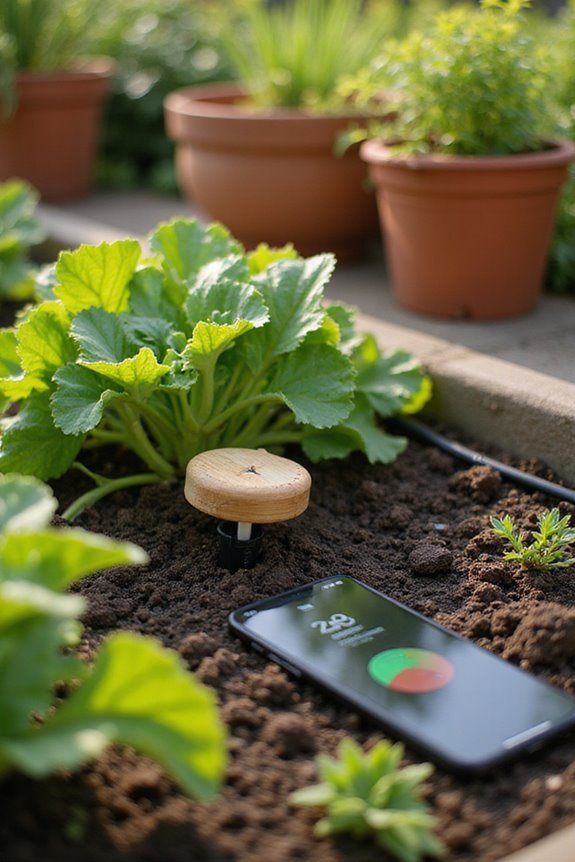
Wireless soil moisture sensors are revolutionizing how we monitor and manage our gardens. These devices use wireless connectivity to deliver precise moisture data, helping us make informed decisions about watering. For example, the SenseCAP sensor employs LoRaWAN technology for long-range communication and impressive battery life. The WH51, on the other hand, links via WiFi and offers quick readings, requiring a separate gateway.
- Types Available:
- LoRaWAN sensors (e.g., SenseCAP)
- WiFi-based sensors (e.g., WH51)
- DIY options with Arduino or Raspberry Pi
- Enhanced sensor accuracy
- Real-time monitoring through mobile apps
- Easy integration into existing smart home systems
With these tools, we can cultivate our gardens more effectively.
Temperature and Humidity Sensors
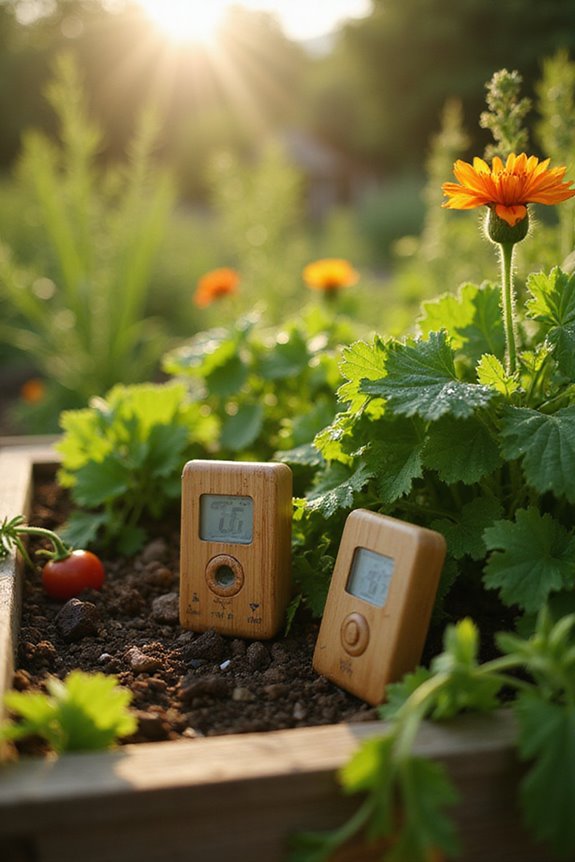
When it comes to managing our gardens, temperature and humidity sensors play an essential role in maintaining ideal conditions. These sensors help us monitor climate factors that are vital for plant health. They can measure temperature ranges from -30°C to 60°C and track humidity thresholds to prevent issues like mold.
- Types of Sensors:
- LoRaWAN® enabled sensors offer long-range monitoring.
- Combined units measure both temperature and humidity.
- High accuracy with ±0.2°C for temperature calibration.
- Some models store up to 2,800 historical data sets for trend analysis.
Using these tools, we can guarantee our gardens thrive by making informed decisions based on real-time data.
Light Sensors
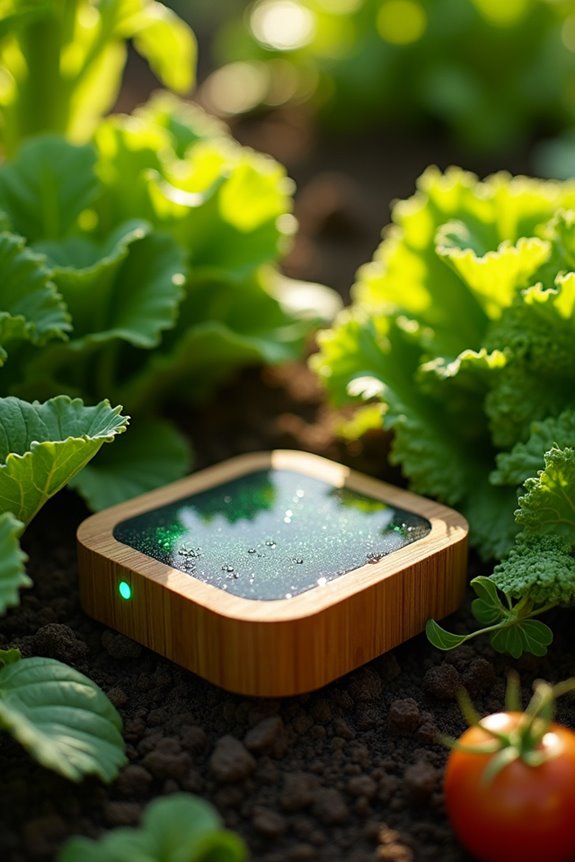
In addition to monitoring temperature and humidity, light sensors are pivotal for optimizing garden conditions. They help us manage smart lighting systems effectively. For example, photocells automatically adjust garden lights based on visible light intensity, ensuring they’re only on when needed.
- Energy Efficiency: Light sensors reduce energy use by turning lights off during daylight.
- Safety and Security: By integrating motion detection, they illuminate areas when movement is detected.
Moreover, smart light sensors enable seamless sensor integration with IoT platforms. This allows us to program lighting based on our specific preferences and environmental conditions. By using these technologies, we enhance our gardens while minimizing light pollution and extending the lifespan of our lighting systems.
Precipitation and Rain Sensors
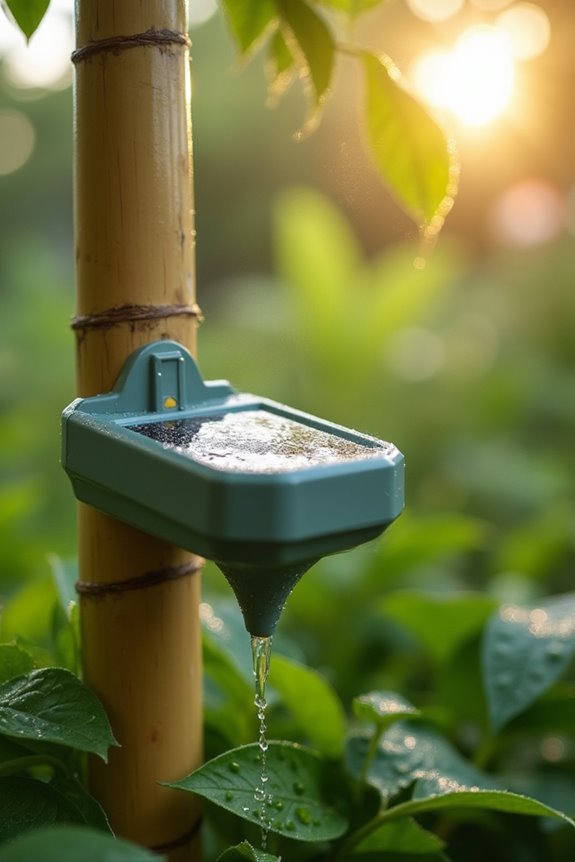
Precipitation and rain sensors play an essential role in managing our gardens and landscapes efficiently. These devices help us make informed decisions about irrigation and water conservation. Two common types are tipping bucket rain gauges and optical sensors.
- Tipping bucket rain gauges collect rain in a funnel, tipping after a set amount and sending signals for recording.
- Optical sensors use laser beams to detect raindrops, offering precise measurements.
Using these sensors can considerably reduce our water usage, saving up to 72% during droughts. They also support better plant health by preventing overwatering. With their ease of integration into existing systems, we can enhance our garden’s sustainability while maintaining an efficient water management strategy.
Wind Speed and Direction Sensors
Wind speed and direction sensors are essential tools for anyone interested in optimizing garden care. They help us understand wind patterns that affect plant health and irrigation. We can choose from various anemometer types, such as cup, sonic, and laser, which measure wind speed accurately.
For wind direction, the wind vane functionality provides vital data on where the wind is coming from, helping us make informed decisions. Combination sensors, like Onset’s S-WSET-B, give us both wind speed and direction in one unit.
These devices are designed for durability, with features to withstand harsh weather. Plus, many offer wireless connectivity, making it easy to monitor our garden from anywhere. By integrating these sensors, we can enhance our gardening experience considerably.
Frequently Asked Questions
How Do I Choose the Right Sensor for My Garden?
When choosing sensors for our garden, we should consider sensor types that measure key environmental factors. By understanding our plants’ needs, we can guarantee ideal growth and create a thriving, connected garden experience together.
Can I Integrate Multiple Sensors Into One System?
Did you know we can reduce water use by up to 40% using integrated sensors? With great sensor compatibility and seamless data integration, we can create a thriving garden together, ensuring healthier plants and shared success.
What Is the Average Lifespan of Garden Sensors?
When we consider the average lifespan of garden sensors, durability factors like material and build quality, along with sensor technology, typically give us a range of 3 to 5 years, depending on usage and maintenance.
Do These Sensors Require Regular Maintenance?
Just like our beloved garden needs care, our sensors do too. Regular sensor upkeep and maintenance tips guarantee they thrive, providing accurate data. We can keep our plants happy by checking and calibrating these helpful devices together!
Are There Any Smartphone Apps for Monitoring Sensors?
Absolutely, we can use smartphone-compatible apps to monitor sensor data effortlessly. These tools help us optimize our gardening efforts, providing real-time insights into environmental conditions, ensuring our plants thrive and fostering a shared passion for gardening.

